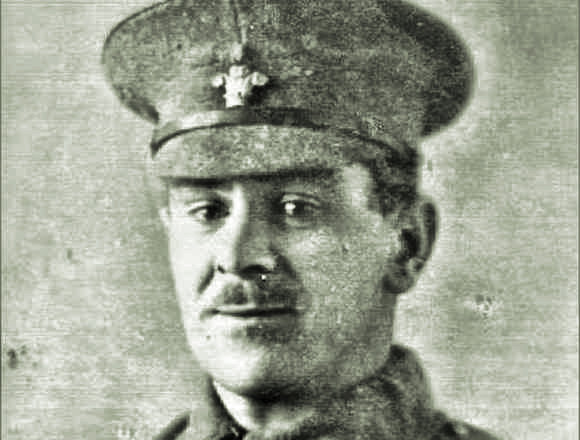 |
| An American Soldier at Notre Dame Bridge, Bar-le-Duc |
Bar-le-Duc is a somewhat rambling town (classified as a commune in France) on the Ornain River in northeastern France that played a critical role in the First World War, most memorably during the 1916 Battle of Verdun. Its wartime population was about 16,000 and hundreds of thousands of French and, later, American troops would move through the town to the battlefields north.
 |
| Starting Point for the Voie Sacrée |
The name Bar-le-Duc is of Gallo-Roman origin. The name of Bar is very probably derived from the bar which the Ornain forms at the spot where the Notre Dame Bridge now stands. At first, a few dwellings were erected at the edge of the river. At a later date, on the east bank of the Ornain, rose a fortified township. In the middle of the tenth century, Frederick I, Count of Bar, built a castle on the hill overlooking the Ornain, to the west, and the Upper Town was created. For much of its history, Bar-le-Duc was a prosperous fortified town which served as the capital of the region, today for the Department of the Meuse. It suffered three years of occupation following the Franco-Prussian war, which was probably bitterly remembered by the older citizens during the Great War.
 |
| Bar-le-Duc's Enormous Rail Yard |
By the early 20th century Bar-le-Duc had become a major transportation center for the region. It was a key station for one of France's east-west mainlines. For its wartime challenges it fortuitously also had a connecting station for the regional narrow-gauge rail service known informally as the Petit Meusien. Similarly, it was also a road hub, the most important of which was the 38-mile paved road to Verdun, which would gain immortality as the Voie Sacrée during the war. In a 1916 article, Scientific American described the initial limitations of this roadway: "This road, at first, like the other average roads of France, fairly narrow, though with a good foundation, would not have been sufficient to prevent congestion and delays, costly if not fatal, when several thousand motor trucks had to run over it in both directions at the same time."
Although the Battle of the Marne is remembered as a French victory, as Wellington said of Waterloo, "It was a near-run thing." Before he was ordered to retreat, Crown Prince Wilhelm's offensive operations brought his army to within a few miles of Bar-le-Duc, and even after the German retreat north, Verdun—utterly essential to France's defenses in the northeast—was in a salient, threatened on a permanent basis from two sides.
 |
| Petit Meusien Carrying Wine Casks |
This new configuration of the front effectively cut the two main rail lines supplying Verdun. The Verdun-Commercy rail line paralleling the Meuse River, which served Verdun from the south, was severed at St. Mihiel, while the line from Reims in the west was under direct observation and artillery range of the Germans camped out in Champagne and the Argonne Forest.
The crisis for supplying and, therefore, holding Verdun did not begin in 1916 with the massive German attack. There was an ongoing tactical threat to the city from September 1914. Before anyone beyond the immediate battlefield read the name Bar-le-Duc in their newspapers, the town on the Ormain River was challenged to play an essential role in defending Verdun. The only communication between Verdun and the rear was by the Verdun-Bar-le-Duc road and the adjacent Petit Meusien narrow-gauge railway, which was requisitioned by the army in 1914. Both had their southern, and secure, terminus in Bar-le-Duc. Improvements were begun almost immediately on both the road and rail line. However, the demands on the two assets in supporting the forts and garrison of Verdun under constant threat were of a different magnitude than for a Verdun under all-out attack. The story of the stupendous logistic system the grew under General Pétain's command in 1916 is told elsewhere on Roads HERE by Christina Holstein and by Robert B. Bruce HERE.
 |
| French Troops at Bar-le-Duc Station |
I came across some interesting facts about Bar-le-Duc, the Voie Sacrée, and the Petit Meusien while putting together this article, so I thought I would conclude with them. For instance, there were four airfields dedicated to defending the route. One of these—the closest to Bar-le-Duc—was the base from which the Lafayette Escadrille won the world's attention in 1916. While much information is available about the road and its maintenance throughout the war, there's not much on the light rail line that, in a twisty way—sometimes crossing back and forth over it—parallels the Voie Sacrée. The two systems were somewhat specialized in their missions, with the rail line carrying food and wine ration for the troops, fodder for the animals, and—on the return trip from Verdun—specially equipped wagons carrying 150-200 wounded Poilus and 200 ambulatory each trip. Later in the 1916 fighting, some of the trains were equipped with long-distance artillery. Meanwhile, on the road, most of the trucks carried troops or ordnance. Bar-le-Duc inevitably became a hospital center and the site of a large military cemetery.
 |
| One of the Infrequent Spots Where the Road and Rail Were Immediately Adjacent |
What was life like in Bar-le-Duc during the war? I've found no written accounts of the experience, but we can surmise a few things. The war mission was round-the-clock, 24/7, so people were up and active all the time. The banging and crashing noise from trucks, trains, and, especially, from the huge rail yard must have been loud and constant. With everyone, whether military or civilian, working long hours, the pressures and the persistent fatigue must have taken a tremendous toll. At the end, however, there was victory, and I'm sure the locals felt great pride. Bar-le-Duc, for a small town, had punched far above its weight during the war.














































